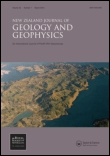
NEW ZEALAND JOURNAL OF GEOLOGY AND GEOPHYSICS
Scope & Guideline
Connecting Scholars Through Groundbreaking Geological Insights.
Introduction
Aims and Scopes
- Geological and Geophysical Research:
The journal emphasizes original research in geology and geophysics, covering a wide range of topics from tectonic processes to sedimentary environments. - Regional Studies of New Zealand:
A consistent focus on New Zealand's geological features, including its tectonic history, sedimentary basins, volcanic activity, and geothermal systems. - Interdisciplinary Approaches:
The journal encourages interdisciplinary studies that integrate geochemistry, petrology, and geophysics to provide a comprehensive understanding of geological phenomena. - Paleontological Insights:
Research on paleobiology and fossil records is also a key area, contributing to the understanding of New Zealand’s geological history and evolution. - Natural Hazards and Risk Assessment:
The journal addresses issues related to geological hazards, including earthquakes and volcanic eruptions, and their implications for society and risk management.
Trending and Emerging
- Geohazards and Earthquake Studies:
There is an increasing emphasis on research related to seismic hazards, particularly in the context of recent significant earthquakes, highlighting the importance of understanding earthquake mechanisms and their societal impacts. - Geothermal Energy Research:
A notable trend towards exploring geothermal resources, particularly in the Taupo Volcanic Zone, supports New Zealand's energy needs and addresses sustainability issues. - Sedimentary Processes and Systems:
Emerging research on sedimentary systems, including source-to-sink studies and sediment transport processes, reflects a growing interest in understanding sediment dynamics in active geological settings. - Paleoclimate and Paleoenvironmental Studies:
There is an increasing focus on paleoclimatic reconstructions and their implications for understanding current climate change, which is particularly relevant given the global emphasis on climate science. - Integration of Advanced Technologies:
The use of advanced techniques such as remote sensing, geophysical modeling, and isotopic analysis is becoming more prevalent, enhancing the understanding of complex geological processes.
Declining or Waning
- Traditional Mineralogy Studies:
Research focusing solely on traditional mineralogy and petrology without integrating modern geochemical techniques or broader geological contexts seems to be declining. - Historical Geology without Modern Context:
While historical geology remains important, studies that do not connect past geological events to current geological processes or risks are becoming less frequent. - Regional Studies Outside New Zealand:
Although the journal primarily focuses on New Zealand, there has been a noticeable reduction in studies that explore geological phenomena outside this region, suggesting a narrowing of geographical focus.
Similar Journals

NORWEGIAN JOURNAL OF GEOLOGY
Exploring Earth's Mysteries, One Article at a Time.NORWEGIAN JOURNAL OF GEOLOGY, published by the Geological Society of Norway, stands as a vital resource in the fields of geology, geochemistry, petrology, geophysics, oceanography, and paleontology. Since its transition to an Open Access model in 2015, this journal has significantly expanded its reach, allowing for greater dissemination of cutting-edge research and insights. With an ISSN of 2387-5844 and E-ISSN of 2387-5852, the journal is committed to fostering collaboration and knowledge exchange among the scientific community. The journal's categorization in the Q3 quartile across various Earth and Planetary Sciences fields underscores its status as a reputable publication, offering researchers, professionals, and students alike a platform to share their findings and advancements in geology. Continuing through its converged years from 2015 to 2024, the NORWEGIAN JOURNAL OF GEOLOGY plays a crucial role in enhancing our understanding of Earth's processes and materials, making it an important reference for anyone engaged in geoscientific research.
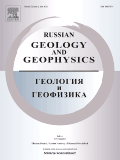
Russian Geology and Geophysics
Unveiling Earth's Secrets, One Study at a TimeRussian Geology and Geophysics is a seminal journal published by GEOSCIENCEWORLD that plays a pivotal role in the dissemination of vital research within the realms of Earth-Surface Processes, Geology, and Geophysics. With an ISSN of 1068-7971 and an E-ISSN of 1878-030X, this journal has witnessed a continuous evolution since its convergence in 2007 and is poised to thrive through 2024. While it is not an Open Access journal, it is recognized for its significant contributions to the academic community, holding a respectable Q2 ranking in Earth-Surface Processes and Q3 rankings in both Geology and Geophysics as of 2023. The journal’s impact factors align it within competitive quartiles, marking it as an essential resource for researchers and professionals seeking to stay at the forefront of geological and geophysical sciences. By publishing high-quality peer-reviewed articles, the journal fosters an environment of knowledge sharing and innovation, making it indispensable for students, practitioners, and scholars alike who are dedicated to advancing our understanding of Earth's complex systems.
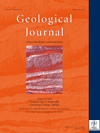
GEOLOGICAL JOURNAL
Uncovering the planet's history with scholarly rigor.GEOLOGICAL JOURNAL, an esteemed publication by WILEY, has been at the forefront of geological research since its inception in 1951. With an ISSN of 0072-1050 and E-ISSN of 1099-1034, this journal serves as a vital platform for disseminating high-quality, peer-reviewed research in the field of geology. Operating out of the United Kingdom, the journal proudly features a Scopus rank of 80 out of 321 in the Earth and Planetary Sciences category, reflecting its commitment to scholarly excellence, with a 2023 category quartile ranking of Q2. As part of its innovative approach, GEOLOGICAL JOURNAL seeks to foster interdisciplinary collaborations, advancing our understanding of earth processes, materials, and history. Although it does not offer open access options, its robust subscription model ensures that both professionals and students have access to groundbreaking insights. With a publication history that spans over seven decades, the GEOLOGICAL JOURNAL continues to be an indispensable resource for the global geological community, encouraging discoveries that shape our comprehension of the planet.
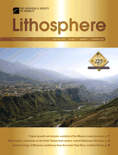
Lithosphere
Unveiling the Mysteries of Our Planet's Lithosphere.Lithosphere, published by GEOSCIENCEWORLD, is a premier open access journal that has been at the forefront of geological research since its inception. With the ISSN 1941-8264 and the E-ISSN 1947-4253, this journal serves as a vital resource for researchers, professionals, and students interested in Earth and planetary sciences, particularly in the field of geology. Its impressive ranking of Q2 in the 2023 category indicates its vital role in disseminating high-quality, impactful research. The journal’s commitment to open access since 2018 enhances its reach, providing global accessibility to cutting-edge studies that span a diverse range of geoscientific topics, from tectonics to sedimentology. With Scopus Rank #88 out of 321 in Earth and Planetary Sciences, it offers a strong platform for scholars to share their findings and engage with the latest advancements in the discipline. As the journal continues its convergence from 2009 to 2024, Lithosphere remains a crucial publication for those striving to deepen their understanding of Earth's systems.
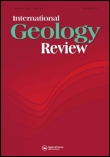
INTERNATIONAL GEOLOGY REVIEW
Fostering a deeper understanding of Earth's processes and materials.INTERNATIONAL GEOLOGY REVIEW, published by Taylor & Francis Inc, is a premier journal dedicated to advancing the field of geology since its inception in 1959. With its Q1 ranking in the field of Geology for 2023, this journal is a significant platform for researchers, professionals, and students exploring the intricacies of Earth and planetary sciences. The journal has been rated in the 81st percentile within Scopus rankings, reflecting its influence and the high quality of articles published. Although it does not offer Open Access options, the journal maintains a rigorous peer-review process to ensure the publication of original and impactful research. With an extensive archive projected to continue until 2024, INTERNATIONAL GEOLOGY REVIEW serves as an essential resource for those seeking to deepen their understanding of geological phenomena, making it a vital contributor to the global scientific community.

Journal of Volcanology and Seismology
Pioneering Discoveries in Volcanology and SeismologyThe Journal of Volcanology and Seismology, published by PLEIADES PUBLISHING INC, serves as a pivotal platform for disseminating innovative research in the fields of volcanology and seismology. With an ISSN of 0742-0463 and an E-ISSN of 1819-7108, this journal aims to contribute to the understanding of geological processes, providing insights that are essential for both academic inquiry and practical applications in hazard management and environmental conservation. The journal spans from 2007 to 2024 and holds a respectable position in the academic community, classified within the Q3 quartile across key categories including Geochemistry and Petrology, Geology, and Geophysics. Despite the absence of an open access model, the journal remains highly relevant, ranking in the 34th Percentile for Geology and the 33rd Percentile for Geophysics, reflecting its commitment to quality and rigor. Researchers, professionals, and students are encouraged to engage with this resource to enhance their understanding and contribute original findings to the ever-evolving disciplines of Earth sciences.

Russian Journal of Pacific Geology
Fostering Innovation in Earth and Planetary SciencesThe Russian Journal of Pacific Geology is a pivotal resource in the realm of Earth sciences, published by PLEIADES PUBLISHING INC. With an ISSN of 1819-7140 and an E-ISSN of 1819-7159, this journal has established itself as a significant publication for researchers, professionals, and students who explore the intricate geology of the Pacific region. Covering a wide array of topics including Geochemistry, Petrology, Geology, Geophysics, Oceanography, Paleontology, and Stratigraphy, the journal's relevance is underscored by its categorization within Q3 quartile rankings across multiple disciplines in the 2023 metrics. Operating from the United States, its influential publications span from 2007 to 2024, attracting a diverse audience dedicated to advancing the geological sciences. Although not an open access journal, it serves as a valuable repository of knowledge, presenting original research, reviews, and critical discussions that enhance scholarly discourse. The journal is recognized within the global scientific community, addressing significant geological challenges while fostering collaboration and innovation among scholars in the Earth and Planetary Sciences.

Geodynamics
Connecting Research and Real-World Geophysical ChallengesGeodynamics is an emerging scholarly journal published by LVIV POLYTECHNIC NATIONAL UNIVERSITY, dedicated to advancing knowledge in the fields of Earth and Planetary Sciences, with a particular emphasis on Geophysics, Geology, and related specialties. Featuring both ISSN 1992-142X and E-ISSN 2519-2663, this journal aims to publish high-quality research that addresses critical challenges in geodynamic processes and their implications on our planet's systems. Despite its nascent status, having converged years from 2023 to 2024, Geodynamics is poised to attract attention in the academic community, especially as evidenced by its rankings in Scopus, which position it prominently within the discipline. The journal's commitment to open access ensures that cutting-edge research is readily available to the global scientific community, fostering collaboration and innovation. Researchers, professionals, and students will find Geodynamics an essential resource for the latest findings and discussions in geodynamics and related fields, making it an invaluable addition to the landscape of environmental science journals.

Solid Earth Sciences
Advancing our understanding of Earth's hidden depths.Solid Earth Sciences is a dynamic open-access journal published by Elsevier, dedicated to advancing our understanding of the Earth's subsurface processes and materials. Since its inception in 2016, the journal has established itself as a vital resource for researchers and professionals in the fields of geochemistry, petrology, geology, geophysics, and geotechnical engineering, achieving a notable Q2 ranking in multiple categories as of 2023. With an ISSN of 2451-912X, the journal aims to disseminate high-quality research that enhances knowledge of earth surface processes and the intricate interactions within our planet's systems. The journal is indexed in Scopus, showcasing an impressive rank in various sub-disciplines, with a rank of #96 in Geology and a noteworthy percentile in Earth and Planetary Sciences. Solid Earth Sciences offers a platform for innovative studies, comprehensive methodologies, and cutting-edge technological advancements that cater to a global audience of scientists, academics, and students. With its commitment to open access, it fosters wider dissemination and impact of research outcomes, ensuring that pivotal discoveries reach stakeholders and contribute to real-world applications.

Quaderni di Geofisica
Catalyzing Knowledge in Geophysics and GeologyQuaderni di Geofisica is a distinguished academic journal published by the IST NAZIONALE GEOFISICA & VULCANOLOGIA-INGV in Italy, focusing on pivotal areas within the fields of geophysics, geology, and computer applications in Earth sciences. Since its inception, this journal has served as a vital platform for the dissemination of innovative research and methodologies, advancing our understanding of geophysical phenomena and their implications. The journal spans various converged years from 2007 to 2019 and 2021 to 2024, allowing for a comprehensive examination of contemporary developments in the field. Despite being categorized in Q3 and Q4 quartiles by Scopus, it plays a critical role in bridging the gap between theory and practice for researchers, professionals, and students alike. The journal's commitment to fostering scholarly communication is underscored by its strategic focus on multidisciplinary studies, making it an essential resource for those engaged in Earth sciences research. Readers can access the journal's content through institutional libraries or by direct request, ensuring a broad reach and ongoing contribution to the global scientific community.